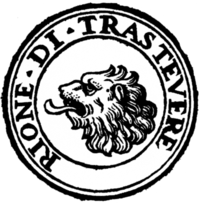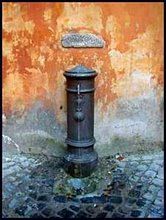 "Pasquino” is the first talking statue of Rome, it became a symbol of the city between the XVI and XIX century. Pasquin (Italian Pasquino) was the name ordinary Romans gave to a battered ancient statue (of the hellenistic age III century A.C. probably an ancient warrior) dug up in the course of paving the Parione district and erected at the corner of Piazza di Pasquino and Palazzo Braschi, on the west side of Piazza Navona in 1501, by Cardinal Oliviero Carafa, who inadvertently gave the statue its first voice, by originating an annual ceremony, the first in 1501, for Saint Mark's Day, April 25.
"Pasquino” is the first talking statue of Rome, it became a symbol of the city between the XVI and XIX century. Pasquin (Italian Pasquino) was the name ordinary Romans gave to a battered ancient statue (of the hellenistic age III century A.C. probably an ancient warrior) dug up in the course of paving the Parione district and erected at the corner of Piazza di Pasquino and Palazzo Braschi, on the west side of Piazza Navona in 1501, by Cardinal Oliviero Carafa, who inadvertently gave the statue its first voice, by originating an annual ceremony, the first in 1501, for Saint Mark's Day, April 25. The marble torso was draped in a toga and epigrams in Latin, in verse or in prose (called pasquinade), were attached to it. The statue spoke out about the people's dissatisfaction, he denounced injustice, and he assaulted misgovernment by members of the Church. The decorous event quickly got out of hand when it became the custom, for those who wanted to criticize the Pope or individuals in his government (for a pasquinade is first and foremost a personal attack), to write satirical poems in broad Roman dialect and attach them to the base of the statue or, more often, to the neck. One of the most known “pasquinade” to Pope Urbano VIII is:
The marble torso was draped in a toga and epigrams in Latin, in verse or in prose (called pasquinade), were attached to it. The statue spoke out about the people's dissatisfaction, he denounced injustice, and he assaulted misgovernment by members of the Church. The decorous event quickly got out of hand when it became the custom, for those who wanted to criticize the Pope or individuals in his government (for a pasquinade is first and foremost a personal attack), to write satirical poems in broad Roman dialect and attach them to the base of the statue or, more often, to the neck. One of the most known “pasquinade” to Pope Urbano VIII is: Quod non fecerunt barbari fecerunt Barberini
Before long, other statues appeared on the scene, forming a kind of public salon or academy, the "Congress of the Wits" (Congresso degli Arguti), with Pasquino always the leader, and the sculptures that Romans called Marforio, il Facchino, and Babuino (the "Baboon"), Abate Luigi and Madama Lucrezia as his outspoken colleagues.

















